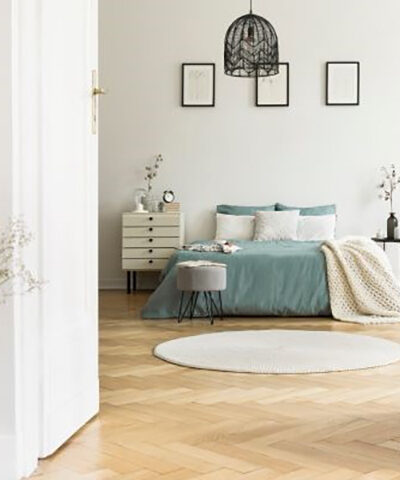Herringbone Wood Flooring
Herringbone is a classic and traditional wood flooring pattern that has been around for centuries. It’s known for its distinctive zigzag arrangement, resembling the bones of a herring fish.
Key features of herringbone wood flooring:
- Pattern: Herringbone consists of rectangular wooden planks or blocks that are laid in a zigzag pattern at a 90-degree angle. This pattern forms a continuous series of “V” shapes across the floor.
- Design Flexibility: Herringbone can be installed with various wood species, finishes, and sizes, making it a versatile choice that can suit both contemporary and traditional spaces.
- Timeless Elegance: Herringbone flooring exudes a timeless and sophisticated look, making it a popular choice for upscale interior designs.
- Installation Complexity: Installing herringbone flooring can be more challenging and time-consuming than some other patterns due to the precision required to create the intricate pattern.
- Visual Impact: The herringbone pattern draws the eye and adds a sense of movement to a room, making it ideal for creating focal points or visually expanding smaller spaces.
Chevron Wood Flooring
Chevron wood flooring is another stunning pattern that is often confused with herringbone. It shares some similarities, but there are key differences that set it apart.
Key features of herringbone wood flooring:
- Pattern: Chevron flooring also consists of rectangular wooden planks or blocks, but they are cut at an angle to create a continuous “V” shape, unlike herringbone’s 90-degree angle. This results in a continuous, arrow-like pattern across the floor.
- Contemporary Appeal: Chevron is often considered more contemporary and modern than herringbone due to its sharp, angular lines and symmetry.
- Simpler Installation: Installing chevron flooring is typically less complex than herringbone because the planks are cut at a consistent angle. This can result in a faster and more straightforward installation.
- Structured Aesthetics: Chevron imparts a structured and dynamic look to a room, which can be particularly effective in minimalist or high-contrast interior designs.
- Elongating Effect: The diagonal lines of the chevron pattern create an elongating effect, making it suitable for spaces where you want to visually extend the room.
In summary, herringbone and chevron wood flooring are both stunning options for adding character and style to your space. The choice between the two comes down to your personal aesthetic preferences and the style of your home. Herringbone offers a timeless and sophisticated look, while chevron provides a more contemporary and structured appearance. Ultimately, the decision depends on the atmosphere you want to create and how you envision the overall design of your interior space. No matter which pattern you choose, both herringbone and chevron wood flooring are sure to make a lasting impression.

